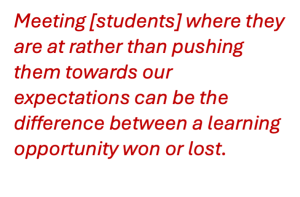We sometimes forget that learners are at different points along the learning continuum. Our students range from beginning to advanced, and all points in between. While we pitch our lessons to the middle, and expect our students to meet the objectives, the students at the lower end of the continuum tend to get left behind. Yet, these learners present us with the greatest opportunity for teaching and learning in the use of differentiated instruction.
Continue readingCategory Archives: Andragogy
Mitigating the Effects of Trauma

“Two of my brothers were killed in the war in Ukraine.”
“My family’s houses were destroyed in Palestine”
“I have PTSD from a trauma in my homeland.”
“There is fighting in my street back home, and I can’t reach anyone.”
“My mother was sent to a re-education centre for being a Uyghur.”
“My husband and I and our two sons were put on a kill list, so we had to flee my country.”
“My sister is sick, and I cannot go back and see her before she dies.”
Continue reading#CDNELTCHAT & #TESLONCHAT : JOIN THE CHAT ON THURSDAY!
If you can, join @Jessifer ‘s webinar earlier on Feb 25 as this will be the basis for our chat (but not essential): https://asuevents.asu.edu/content/design
Below is a recap of the January 26 chat written by #CdnELTchat moderator Jennifer Chow.
Noticing – An Essential Tool for L2 Acquisition – Part 2 of 2

Noticing theory in the context of cognitive linguistics seems to offer an interesting insight into the processes accompanying second language acquisition focusing on the problems of attention, awareness and memory. “Noticing” – despite disagreements in defining the term – seems to function as a gateway into these processes in Richard Schmidt’s (1995) deliberations. An ESL instructor “in the field,” might have burning questions such as these: How is noticing initiated? Is it totally subjective and personalized, or does it have some regularities that could be exploited in the classroom? If the latter is true, then what are the stimulants? How can one effectively manage the process of transforming “comprehensible input” into “noticed intake”?
Continue readingCalling our students by their names

~A rose by any other name would smell as sweet. But would it, really?
My name, Jennifer, comes from the Welsh Gwenhwyfar. It means “white wave” or “fair lady.” Although I don’t see myself as a “lady,” I do like the rhythmic majesty of “wave.” The tumbling, repetitive motion of it. But if it weren’t for the research I did, I wouldn’t have a clue what my name means. My parents certainly didn’t put much thought into it; they just liked it. Indeed, according to Ye Chongguang, “Chinese names are often chosen for their meaning, but English names are chosen for their sounds” (Lee, 2001).
Continue readingCritical Reflection in Action-based Approaches

The role of critical reflection is very important in action-based approaches to problem solving. Reflecting allows us, as researchers and educators, to think about what can be done after an observation of a particular method and how action can be taken to fix or alter the process of the method to make it more effective. “Being able to explain what you are doing and why you are doing it also enables you to be clear about its significance for your field, which is important when it comes to saying why your research should be believed and taken seriously by others, especially peers” (McNiff, 2011, p. 10).
Continue readingThe Role of the L1 in the EFL Classroom Part I: What Research Says

In a time where TESOL teaching is turning away from prescriptive methods, and teachers may have the increasing freedom and responsibility of adapting to their students’ needs, a question that faces ongoing consideration is whether or not the first language (L1) has a role in the EFL classroom. The good news for teachers who engage or would like to engage L1 use in the classroom is that this approach is strongly backed by theory and research-based evidence in the field of second language acquisition. Here, in the first part of a three-part series on this topic, I will outline this body of support for incorporating the L1.
Continue reading#CdnELTchat: join the chat on Tuesday!

#CdnELTchat is back on Tuesday, Jan. 29th to discuss “Balancing Language and #EdTech in the Classroom”. We hope that you can join them. #ELT #CdnELT @EALStories @StanzaSL @LINCInstructor @bcteal @TESLOntario @TESLCanada
Here’s a recap of their January 15th chat.
#CdnELTchat got off to a thoughtful start in 2019 with a focused chat on Resolutions in #ELT. Jennifer Chow (@jennifermchow) led the discussion by posting the questions, with Augusta Avram (@LINCinstructor) and Bonnie Nicholas (@EALstories) welcoming participants and replying to posts, and Svetlana Lupasco (@StanzaSL) providing support in the background. The team has published an article reflecting on their experiences with #CdnELTchat, Building a Community of Connected ELT Professionals on Twitter. The article appears in the most recent issue of the TESL Canada Journal Special Issue, The Shifting Landscape of Professional Self-Development for ELT Practitioners. Continue reading
#CdnELTchat: join the chat on Tuesday!
 If you’re a Twitter user, join the next #CdnELTchat usually every second Tuesday. Below is a recap of the November 27th chat from the #CdnELTchat moderators.
If you’re a Twitter user, join the next #CdnELTchat usually every second Tuesday. Below is a recap of the November 27th chat from the #CdnELTchat moderators.
I have been learning how to speak Mandarin for the better part of twenty years, but I still can’t produce the fourth tone correctly. I automatically say the first tone instead of the fourth tone in conversation. I am aware that I do this, yet I can’t seem to correct this bad habit. Is this a fossilized error? Is there anything I can do to overcome this error? On November 27th, a group of educators discussed these questions and more on #CdnELTchat.
Thank-you so much to the enthusiastic participants who contributed their ideas and shared resources during this chat. Continue reading
Reflections on the implementation of PBLA

“You have to get your SBA’s, SUA’s, T’s and A’s in order to have an organized portfolio, Sridatt,” said the Lead Instructor of Portfolio Based Language Assessment (PBLA) implementation. “You also have to get,” continued the official, “peer evaluations [PE’s], learner reflections [LR’s], and inventory checklists [IC’s], all in order to have a good, organised portfolio.” The order and presentation of the portfolio, not the teaching of the language itself, seems paramount. I welcome myself to the new world of English as a second language teaching, even though my new teaching practices are not aligned with my educational philosophy.
By the time the individual was finished, I was beginning to see a sort of preoccupation over skill building activities (SBA’s), skill using activities (SUA’s) tasks (T’s) and assessments (A’s). When the individual was gone, it didn’t take much reflection to conclude that Portfolio Based Language Assessment (PBLA) seems to be a faulty assembly line approach to education. Continue reading


